Today, we’re making Cheonggukjang Jjigae!

Cheonggukjang Jjigae is one of my favorite Korean stews!
Cheonggukjang is made by boiling soybeans, then leaving them to ferment for 2-3 days.

Cheonggukjang is sold in the refrigerator section of a Korean mart
As they sit, the boiled soybeans ferment via Bacillus Subtillis, a bacteria which is contained in the surrounding air (or rice straw).
(This is in contrast to Japanese natto, to which Bacillus Subtillis is added from a culture or another batch of natto.)
But how is it different from Doenjang?
Both start by boiling soybeans.
As mentioned, Cheonggukjang is fermented for only a few days.
But Doenjang is fermented for much longer, typically for a month or longer.
For texture, Cheonggukjang still contains whole beans. But in Doenjang, the beans have crumbled and mushed into a paste.
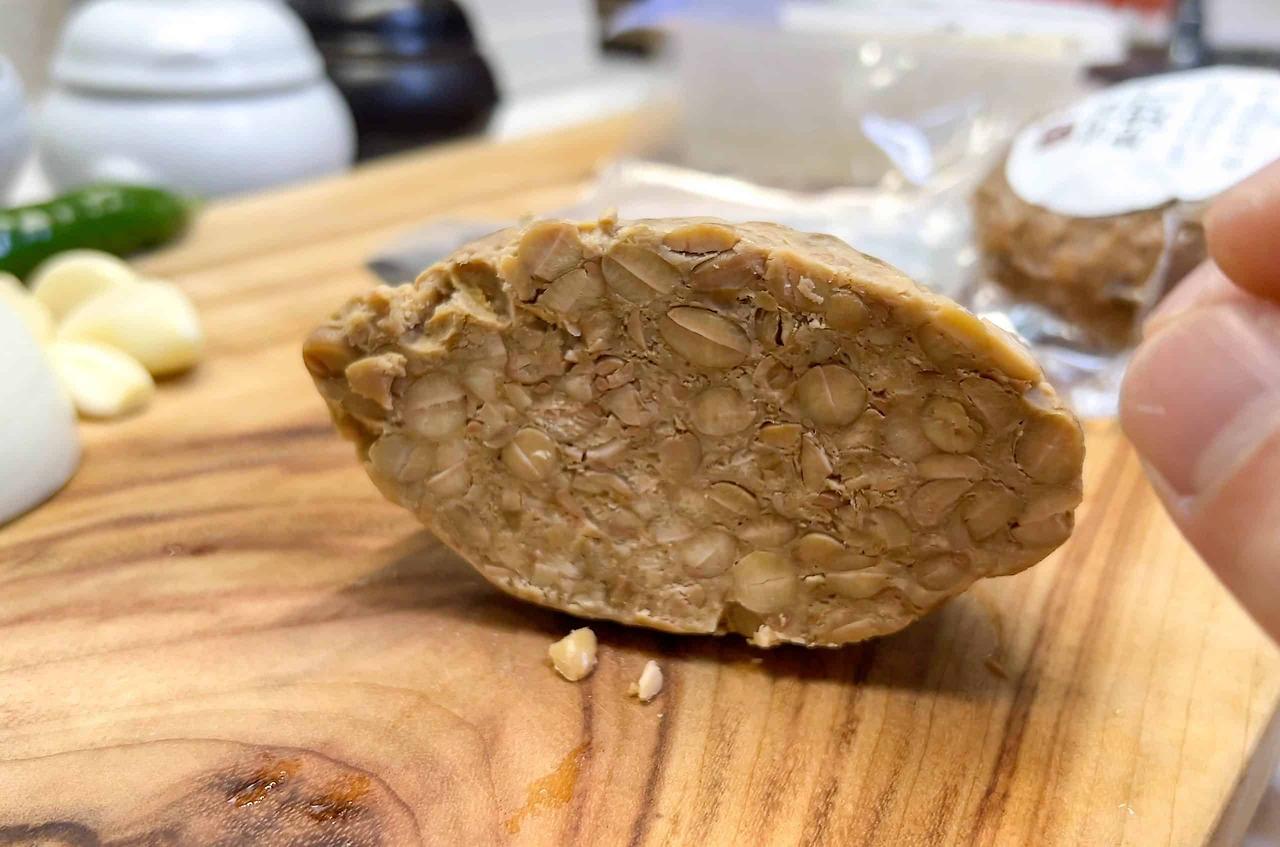
I cut the Cheonggukjang block in half - but you can see the whole beans
When compared to other Soybean Pastes, Cheonggukjang is believed to deliver the most amount of nutrition and the easiest to digest.
It contains an abundance of vitamins and minerals, including calcium and potassium – which aids in boosting metabolism and obesity prevention.
It’s also packed with genistein. This naturally occurring compound has anti-carcinogenic effects, especially for breast cancer, colorectal cancer, rectal cancer, and stomach cancer.
Now I must stop here and address the elephant in the room…
Cheonggukjang has a very pungent smell!
It’s not universally enjoyed in Korea – as many people dislike the strong smell.
But I personally LOVE it.
I love the texture of the whole beans.

And the pungent smell only adds to the flavor!
However, I am Korean and my bias is strong. Plus my mom liked to cook this stew for us during my younger years.
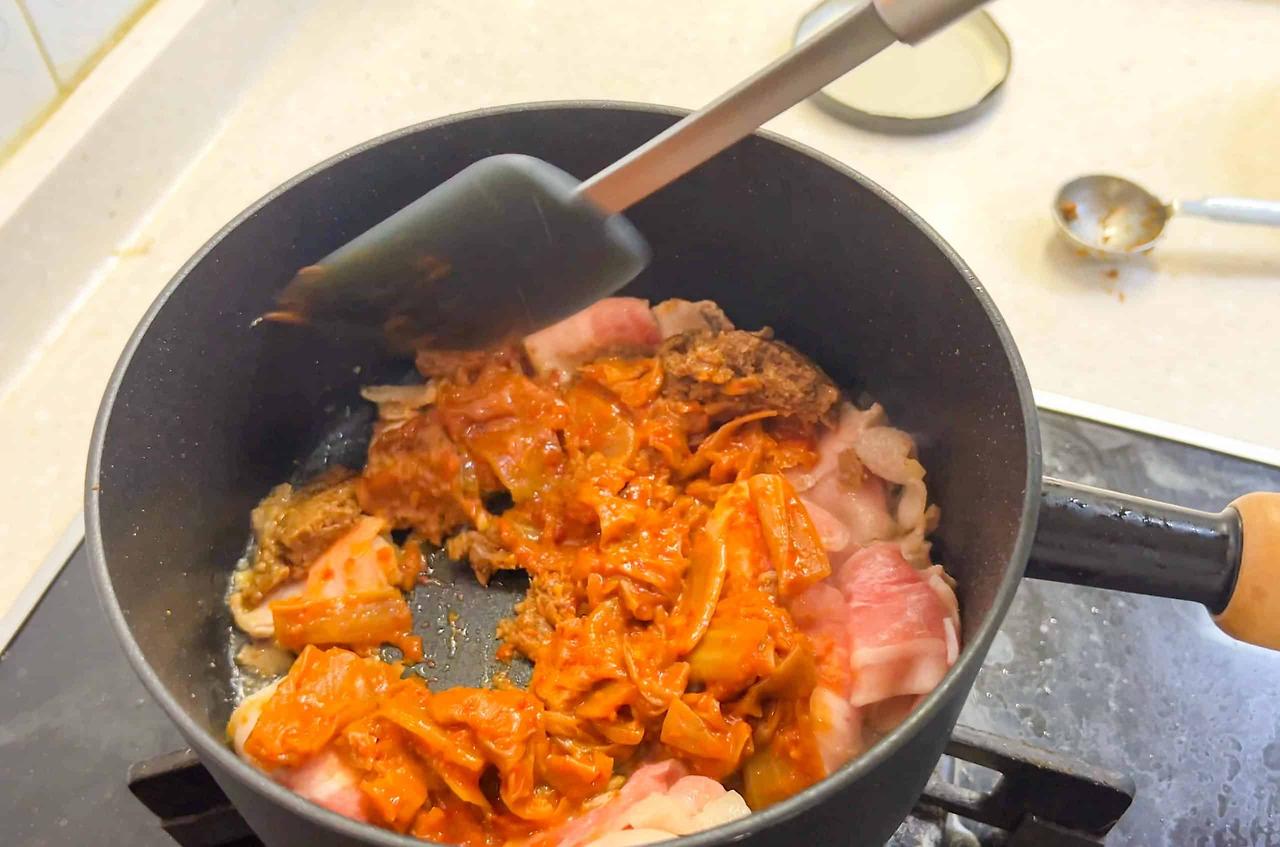
Building the flavor by stir-frying first!
(So if you’re new to Korean cooking, start with our Signature Doenjang Jjigae – much easier on the palate!)
But for those who are already familiar with Korean Doenjang, allow me to share my personal cheonggukjang recipe!
The taste is similar to Cheonggukjang Stews that you’ll find at Korean BBQ restaurants here in Seoul.
It’s packed with flavor… stir-fried with kimchi, doenjang, then seasoned with garlic and a teaspoon of gochugaru for a reddish tint.
Cooking notes for Cheonggukjang:
You’ll need 2.5 cups (625ml) of Anchovy-Kelp Stock.
But this can be substituted with 2.5 cups of Rice Water (살뜨물).
(Or another substitution, use 1 Anchovy-Kelp Broth Tablet + 2.5 Cups of Water)

We used this anchovy-kelp broth TABLET + 2.5 cups of water
Feel free to add additional vegetables.
Use Aged Kimchi if you have any in your refrigerator - not fresh.
If not, go to the Korean supermarket and you'll find Stir-fried Kimchi (볶음김치) that's sold in small packets or cans - works just as great!

Use Stir-fried Kimchi for the recipe!
You can replace the pork slice with beef (but make sure the cut has some fat in it).
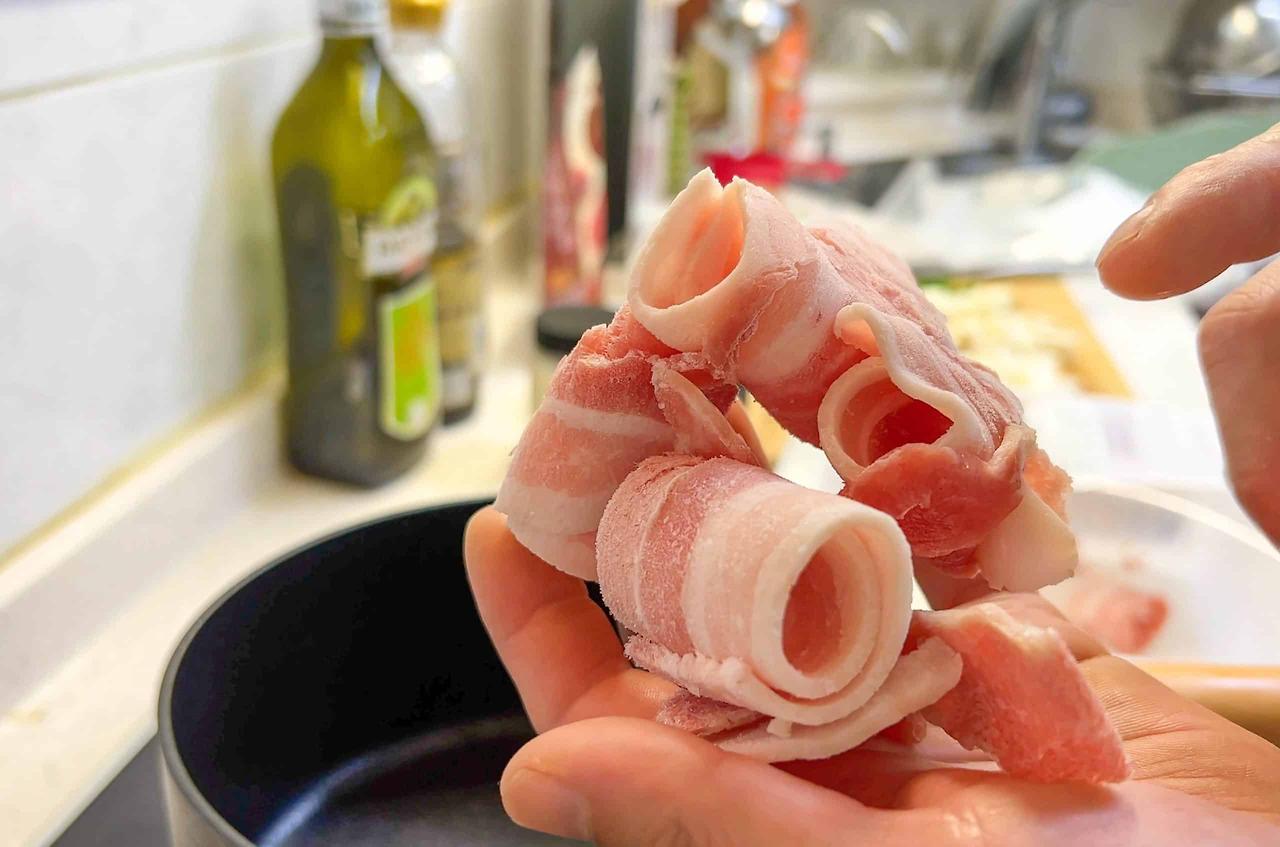
I prefer Daepae Samgyeopsal the most!
For newbies, make sure to get some rice cooking in the background. This is not a stew you eat straight – it’s meant to be spread over rice.
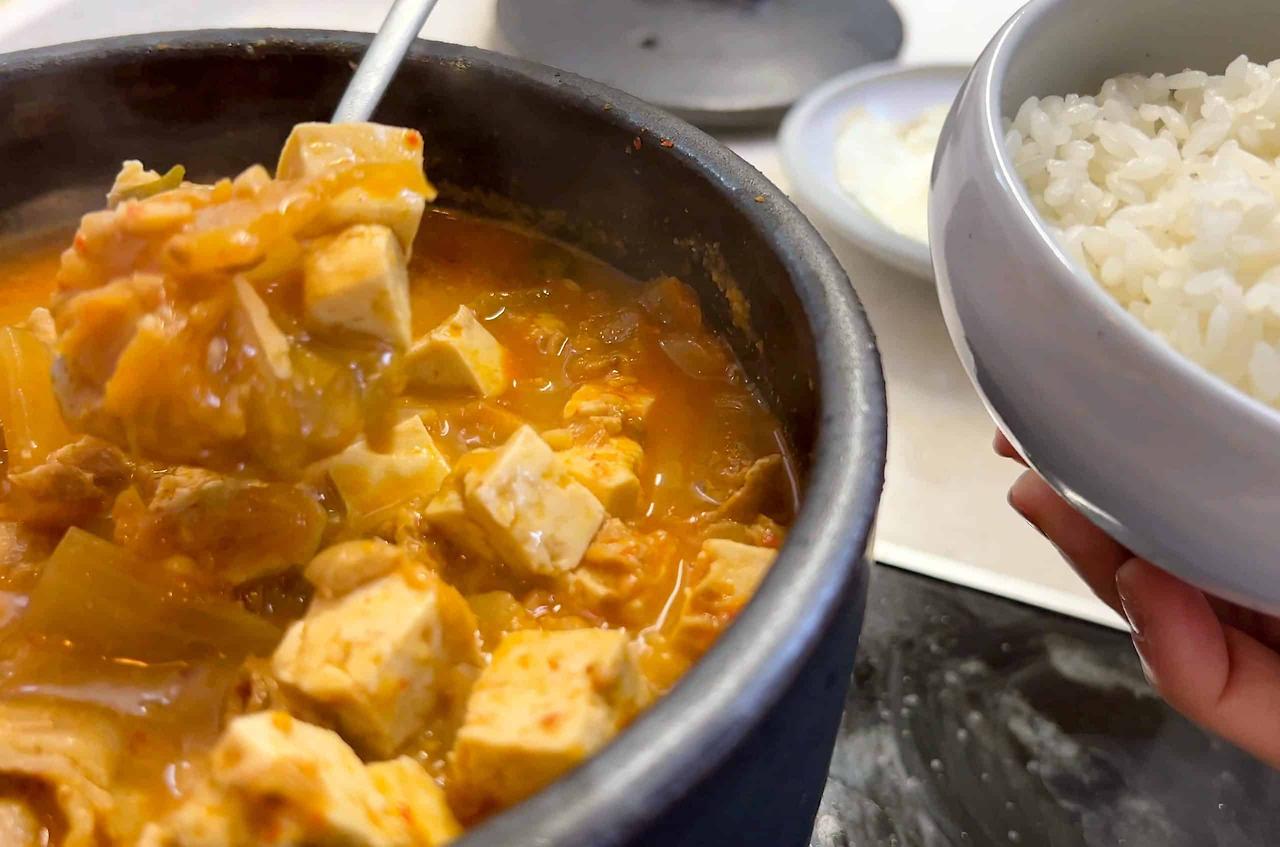
Eat with rice ya'll!
In the recipe, when it says to reduce for 5 minutes… follow it! The stew needs some boiling time for the flavors to come together.
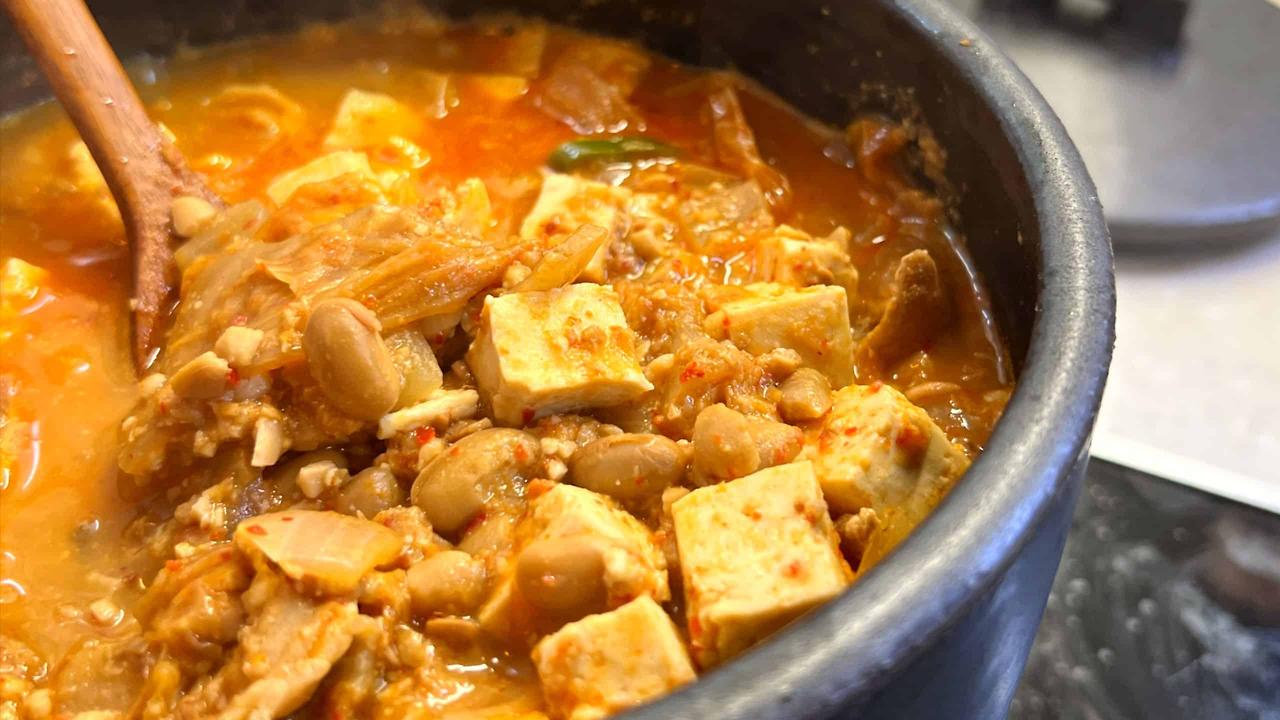
Look at how hearty that looks ya'll!
Neighbors - one thing.
We love waking up and scrolling through picture of your dishes! If you made this recipe, tag us on IG!
And if you're cooking alone tonight, no worries! Listen to our latest podcast as you prep 😀
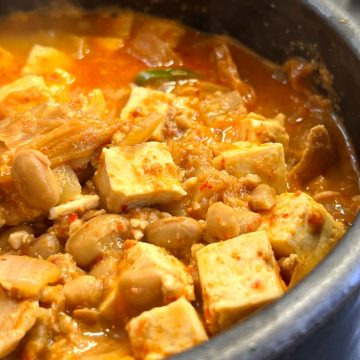
Ingredients
- 1 handful of Dapae Samgyeopsal (대패삼겹살) 100-150 grams of Thinly Sliced Pork Belly (or use beef)
- 125 grams of Cheonggukjang (청국장)
- 2.5 Cups Anchovy-Kelp Broth (or use Rice Water 쌀뜨물)
- 4 cloves Garlic
- 1 teaspoon(!) Gochugaru Flakes
- ½ whole Onion
- ½ Block Firm Tofu (150 grams)
- 2 Heaping Tablespoons Doenjang Paste
- ½ Cup Aged Kimchi (or use Stir-Fried Kimchi)
- ½ a whole Cheongyang Chili Pepper (or ½ a Jalapeno Pepper)
Instructions
Prep Ingredients
-
Dice ½ an onion into bite-sized pieces.
-
Dice ½ a block of firm tofu (150 grams) into bite-sized cubes.
-
Slice ½ a Cheongyang Chili Pepper into thin slices.
Stir-fry Ingredients
-
Take out a pot. Add-in just a dash of vegetable oil. Place it on medium-heat.
-
Once the oil is hot, add in a handful (~100 grams) of thinly sliced pork belly (or beef slices).
-
Then add in 2 heaping Tablespoons of Doenjang Paste.
-
Then add in ½ Cup of Stir-Fried Kimchi (or Aged Kimchi).
-
Make sure the heat is on medium. Stir-fry everything for 1-2 minutes (or until the pink in the meat is gone).
Add Broth and Make Stew
-
Then add in 2.5 cups (625 ml) of Anchovy-Kelp Broth (or Rice Water).
-
Once the stew comes to a boil, add in the chopped onions + tofu cubes.
-
Next, add in the minced garlic (4 cloves worth).
-
Set a timer for 5 minutes ... and let it all boil together.
-
After 5 minutes, add in the block of Cheonggukjang (~120g).
-
Carefully stir the block into the stew and break it up - so there's no clumps.
-
Once it's well-mixed, add in the sliced Cheongyang Chili Peppers.
-
Now, add in the Gochugaru Flakes (1 teaspoon!) - this will bring an appetizing red tint to the stew.
-
Reduce the heat to a low - and let the stew boil together for another 5 minutes. (This final 5 minutes is when all the flavors come together).
-
After 5 minutes, turn off the heat. The stew is ready!
-
Give it a taste - and if it's slightly salty, add in a dash of water.
-
Make sure to serve the stew with a bowl of freshly cooked rice.
-
Bon Appetit!